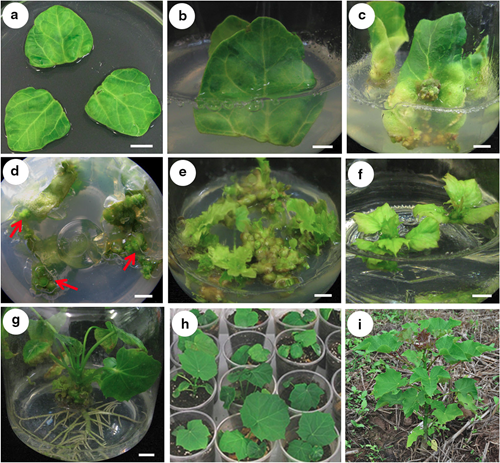Plant Biotechnology Reports:中科院版纳植物园徐增富研究组建立能源植
近期,国际学术刊物《Plant Biotechnology Reports》发表中国科学院西双版纳热带植物园研究员徐增富研究团队发表小桐子遗传改良研究文章,题为“An efficient protocol for Agrobacterium-mediated transformation of the biofuel plant Jatropha curcas by optimizing kanamycin concentration and duration of delayed selection”。
能源植物小桐子(Jatropha curcas)又名麻疯树、小油桐、膏桐等,是一种多用途的大戟科多年生木本油料树种,具有“不与人争粮、不与粮争地、不与地争肥”的优点,其种子含油率一般在30%~40%之间,是国际公认的最适宜作为生产生物柴油和生物航空燃油原料的能源植物之一。但目前在大面积生产上缺乏高产的小桐子优良品种,致使其种子产量低且不稳定,无法满足生物燃油产业大规模发展的需求。因此,利用转基因技术对小桐子进行分子遗传改良,培育高产的优良品种,对于生物能源产业发展具有重要意义。
近期,该研究团队科研人员付乾堂等人在前期建立的农杆菌介导的小桐子基因转化方法的基础上,系统地对乙酰丁香酮的添加、农杆菌菌株的选择、转化子的筛选策略、抗生素选择压力的确定以及生根培养基的配方等影响遗传转化效率的几个关键因素进行了优化。采用优化后的小桐子转基因方法,从外植体与农杆菌共培养到获得生根的转基因再生植株,整个遗传转化过程只需4个月。该转基因技术具有简单、高效和可重复的优点。
小桐子高效转基因技术的建立为今后系统开展小桐子功能基因组研究和利用转基因技术培育小桐子优良品种提供了有效的方法。

农杆菌介导的小桐子遗传转化过程
原文链接:
An efficient protocol for Agrobacterium-mediated transformation of the biofuel plant Jatropha curcas by optimizing kanamycin concentration and duration of delayed selection
原文摘要:
Jatropha curcas is considered a potential biodiesel feedstock crop. Currently, the value of J. curcasis limited because its seed yield is generally low. Transgenic modification is a promising approach to improve the seed yield of J. curcas. Although Agrobacterium-mediated genetic transformation of J. curcas has been pursued for several years, the transformation efficiency remains unsatisfying. Therefore, a highly efficient and simple Agrobacterium-mediated genetic transformation method for J. curcas should be developed. We examined and optimized several key factors that affect genetic transformation of J. curcas in this study. The results showed that the EHA105 strain was superior to the other three Agrobacterium tumefaciens strains for infecting J. curcas cotyledons, and the supplementation of 100 mM acetosyringone slightly increased the transient transformation frequency. Use of the appropriate inoculation method, optimal kanamycin concentration and appropriate duration of delayed selection also improved the efficiency of stable genetic transformation of J. curcas. The percentage of β-glucuronidase positive J. curcas shoots reached as high as 56.0 %, and 1.70 transformants per explant were obtained with this protocol. Furthermore, we optimized the root-inducing medium to achieve a rooting rate of 84.9 %. Stable integration of the T-DNA into the genomes of putative transgenic lines was confirmed by PCR and Southern blot analysis. Using this improved protocol, a large number of transgenic J. curcas plantlets can be routinely obtained within approximately 4 months. The detailed information provided here for each step of J. curcas transformation should enable successful implementation of this transgenic technology in other laboratories.
作者:徐增富

